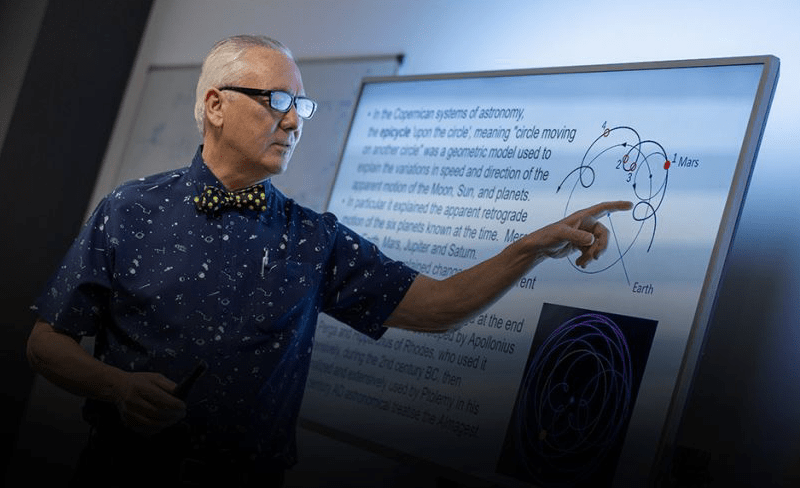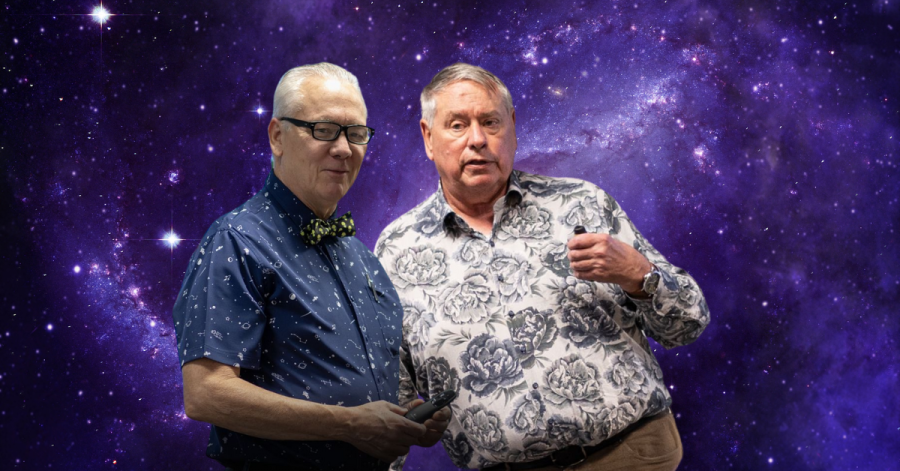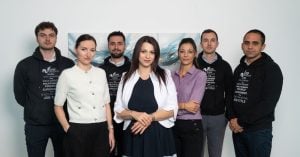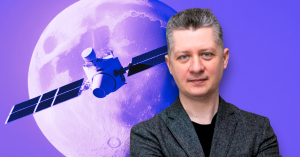In the vast expanse of the universe, there are those who dream, and then there are those who turn these dreams into reality. Enter Dr. S. Pete Worden and Pete Klupar. Worden, the former Director of NASA’s Ames Research Center and now the Executive Director of Breakthrough Initiatives, has been at the forefront of space exploration, with over 150 scientific papers under his belt and a reputation for fostering international partnerships. Klupar, with a penchant for high-tech, low-cost space missions, has launched over 50 spacecraft missions and has been a pivotal figure in reshaping the economics of space exploration.
The Recursive had the distinct privilege of conversing with these two space luminaries during their visit to Sofia for the Space Challenges Program Boot Camp 2023. Organized by the innovative spacetech company EnduroSat, this educational program is a melting pot of knowledge, offering participants a deep dive into the intricacies of space sciences and engineering. With experts like Worden and Klupar collaborating with the next generation of space enthusiasts, the horizon of space exploration is set to expand even further. Dive into our enlightening conversation to discover the insights and aspirations they shared.
Use the bullet points below to jump to the section of the interview that interests you most:
- Dr. S. Pete Worden and Pete Klupar on their participation in the Space Challenges Program Boot Camp 2023 organized by EnduroSat and their thoughts on the CEE region’s potential when it comes to space exploration
- Dr. S. Pete Worden on the importance of collaborations between governments and the private sector & the search for potentially habitable worlds in Space
- Pete Klupar on why startups will eat larger corporations & the future of space travel
- Dr. S. Pete Worden and Pete Klupar discuss UFOs
In this first part of the interview, Dr. S. Pete Worden and Pete Klupar discuss their participation in the Space Challenges Program Boot Camp 2023 organized by EnduroSat and share their thoughts on the CEE region’s potential when it comes to space exploration
Dr. Worden/Mr Klupar, what motivated you to participate in the Space Challenges Program Boot Camp 2023 organized by EnduroSat?
S. Pete Worden: We recognize that the objectives we’re pursuing—unveiling the mysteries of life in the universe—are ambitious and far-reaching. This isn’t a task confined to a single generation; rather, it’s a continuous endeavor. It holds immense significance to inspire the forthcoming generation of scientists, engineers, and other specialists. We’re passing on the torch for addressing questions that may take decades to fully explore.
Pete Klupar: Well, let me explain this with a bit of context. There was the initial wave of space exploration led by the Apollo generation, a time when monumental strides were driven by the urgency of the space race. These pioneers embraced risks to achieve remarkable feats. However, as my generation came along, the momentum dwindled. Space endeavors slowed, and the frequency of launches went from weekly to monthly, and sometimes even yearly. Progress seemed to halt as we funneled our resources into a handful of massive projects.
Now, here’s where programs like Space Challenges come in to propel the newer generation. The paradigm needs shifting back to the daring spirit that fueled the early days of space exploration. We need to revert to trying numerous approaches, just like during the space race. So, I see your generation as the catalyst for reversing the stagnation my generation contributed to. The way forward is to explore diverse paths, embrace novel risks, and uncover new knowledge. The traditional method of investing vast resources and years into a single colossal project, like the James Webb Telescope, is inefficient. It’s akin to planting one giant flower, whereas planting many different flowers is far more productive. That’s my aspiration: to sow a multitude of seeds, to ignite enthusiasm, and to galvanize a collective effort that can address challenges with creativity and diversity, ultimately leading to innovative solutions.
How do you envision the impact of programs like Space Challenges on the future of space exploration and innovation?
S. Pete Worden: Historically, the challenge with space exploration has been its exorbitant costs and protracted timelines. However, the landscape is ripe for transformation through the infusion of novel technologies, concepts, and methodologies.
Back when Pete Klupar and I were in our youth, space endeavors were exclusive to nations with comprehensive governmental involvement—such as the Soviet Union, the United States, and subsequently, China and India. This entailed lengthy project durations and limited accessibility. Yet, the emergence of innovative technologies, especially the advent of miniature satellites that can be constructed even within a small workspace (literally in a garage), has revolutionized space accessibility. Today, virtually anyone can engage in space-related activities. This democratization has paved the way for a multitude of individuals with fresh ideas to embark on technological innovation.
Pete Klupar: I’m truly amazed by it. You see, there’s an incredible reservoir of untapped potential. Currently, EnduroSat has around 100 individuals dedicated to these challenges. However, consider this: Bulgaria boasts a population of 5 to 10 million. I have a vision where a substantial portion of these individuals become engaged in tackling these very challenges. Bulgaria has a robust education system, and the key lies in encouraging a significant percentage of these individuals to focus their thoughts and efforts on space-related matters. Their collective brainpower can unlock solutions to the hurdles we face.
Given your extensive experience in the space sector, how do you perceive the potential of Bulgaria and the CEE region in contributing to spacetech innovation?
S. Pete Worden: Certainly, the evolving technological landscape has democratized participation, allowing everyone to be part of the equation. A key insight I’ve gained over time is that ingenuity and valuable concepts are not confined to specific nations or societies. Bright minds and innovative ideas are universally distributed, and diverse perspectives often lead to groundbreaking solutions that reshape established norms.
EnduroSat serves as a notable example of this phenomenon. In the absence of predefined conventions, there’s room for pioneers to forge new paths in space exploration. The founders of EnduroSat, free from any restrictive ‘this is how it’s done’ mentality due to the absence of precedence, have harnessed this freedom to devise novel approaches. These approaches are not only cost-effective but also surpass conventional practices in quality. Their innovations have unveiled unanticipated possibilities, even ones that I wouldn’t have envisioned.
Are there any specific areas or niches within spacetech where you believe Bulgaria and the CEE region can excel or lead on a global scale?
S. Pete Worden: Undoubtedly, the true advantage lies in the shift towards a commercial paradigm. The realization that government involvement isn’t an imperative, and that individuals possessing diverse technical proficiencies can contribute, is a transformative concept. This phenomenon isn’t exclusive to Bulgaria alone; it characterizes many regions that historically weren’t associated with space endeavors. This newfound perspective opens avenues for novel ventures, driven by fresh thinking.
The ingenuity and excellence displayed by the students I’ve encountered (the ones taking part in the Space Challenges Program Boot Camp 2023 organized by EnduroSat) have left a lasting impression on me. It’s clear that they possess a remarkable capacity for creativity. If I were initiating a company, these are individuals I’d eagerly bring on board.
Pete Klupar: The key isn’t about achieving leadership per se. Rather, it involves identifying areas where existing technologies and methods from various sectors can be harnessed for space purposes. There’s a lesson to be learned from the evolution of cell phones, which ultimately surpassed the capabilities of spacecraft. The brilliance of EnduroSat lies in their approach of integrating commonplace elements from across industries into space endeavors. The strength isn’t necessarily in creating entirely novel, elaborate systems, but rather in leveraging existing resources to solve space-related challenges. This unique strategy is what sets them apart and is often overlooked by others in the field.
In this next part of the interview, Dr. S. Pete Worden talks about the importance of collaborations between governments and the private sector & the search for potentially habitable worlds in Space

Having served as the Director of NASA’s Ames Research Center and now as the Executive Director of the Breakthrough Initiatives, can you share some insights on the differences and similarities in working with a government space agency versus a private organization?
Certainly, when dealing with a government structure, a major challenge arises due to the intricate web of decision-making. Obtaining approval is a convoluted process, often requiring consensus from numerous individuals. This complexity frequently necessitates compromises and adjustments to navigate through the bureaucracy.
Nonetheless, the advantage of government agencies, like NASA, is their substantial resources and well-established expertise. NASA, with its history and intellect, remains a formidable institution.
Transitioning to private organizations, such as the Breakthrough Initiatives, the dynamics shift. In the commercial realm, the power to say ‘yes’ rests with a smaller, often singular, leadership group. Persuading one decision-maker, or a handful at most, proves significantly more streamlined. This is particularly pronounced if you happen to be that decision-maker, as evident in the case of figures like Elon Musk.
Elon Musk serves as a prime example of an individual with a divergent vision. Starting with considerable capital and progressively amassing more, he effectively swayed governments to fund his ventures. This model isn’t exclusive to him; there are numerous startups across the globe with a similar trajectory. My involvement spans across continents. For instance, Luxembourg boasts more than 80 startups. Eastern and Southeastern Europe are becoming incubators for new ventures, leveraging a wealth of talent and investor interest. It’s not confined to Europe either; my recent experiences in Kenya and Rwanda highlight the proliferation of startups and small satellite projects. Even the Kingdom of Bhutan has taken its first steps in space with the launch of small satellites, driven by the ambition of His Majesty the King to harness space as an inspirational tool for previously untapped scientific interest.
This shift in landscape ushers in fresh expertise and hitherto unexplored opportunities, underscoring the transformative nature of the evolving space industry.
Having witnessed the evolution of space missions from your time at NASA to your current role at the Breakthrough Initiatives, how do you think the objectives and methodologies of space exploration have transformed over the years?
When I reflect on the origins of space science and exploration in the 1960s, a notable feature was the frequent mission failures. These early setbacks prompted the formulation of stringent rules and protocols. Consequently, undertaking a new mission after that era translated into a decade-long endeavor just for approval. Following that, another decade transpired for mission development, typically culminating in large, resource-intensive projects.
Under this framework, it was challenging to foster a sense of individual ownership; missions were often attributed to a collective effort. A prime illustration of this dynamic is the Kepler mission, a significant endeavor I was a part of at NASA Ames. This mission fundamentally revealed that a vast majority of stars within the galaxy harbor planetary systems. This underscores the challenge of dedicating an entire career to a single mission, which can be quite unsatisfying.
Presently, the landscape has experienced a significant shift. The timeframe required to conceptualize, create, and execute a mission has been drastically condensed. Today, missions can be accomplished within a year’s span, enabling professionals, including students, to engage in multiple endeavors throughout their careers. This shift introduces a sense of reward and progress. Moreover, the accelerated pace of mission development provides invaluable learning opportunities. When you only engage in a single mission, lessons remain scarce. However, with the possibility of multiple missions, around ten or even twenty, the approach becomes iterative. This means that lessons from one mission can inform the next, enabling growth and refinement.
This change isn’t confined to scientific endeavors; it extends to the commercial sphere as well. In the nascent stages of commercial space initiatives, the time investment was substantial, often spanning decades. In contrast, contemporary companies can initiate with smaller spacecraft and test the market. If a design fails to garner interest, modifications can be swiftly implemented based on feedback.
In essence, the newfound ability to iterate, improve, and adapt stands as a pivotal transformation in space exploration and science. It echoes the principles of scientific experimentation, allowing for incremental progress, and significantly impacting how we approach science and engineering, both in space and on Earth.
Breakthrough Starshot aims to demonstrate proof of concept for ultra-fast light-driven nanocrafts and has aspirations for a launch to Alpha Centauri within the next generation. Can you provide insights into the current stage of this initiative and highlight one or two of the most critical challenges and discuss the strategies in place to overcome them?
Our journey began in 2016 with a focused effort to bring to fruition the audacious vision of deploying probes to the nearest star system—a goal that would necessitate achieving this feat within a mere couple of decades following launch.
During the initial year, we embarked on a comprehensive exploration of various concepts to realize this ambitious aspiration. Many concepts failed to align with our objectives, proving either prohibitively costly, excessively time-consuming, or fundamentally unworkable. Eventually, we arrived at a concept that demonstrated promise. While some ideas had originated in the 70s and 80s, it was the pioneering work of Professor Phil Lubin at the University of California, Santa Barbara, that laid the groundwork. We recognized that we had a potential solution, yet multiple challenges—what we term ‘deal breakers’—needed resolution. Approximately 25 issues arose, but a select few were critical to overcome.
The first challenge was engineering a minuscule spacecraft with an attached sail. This sail, a mere four or five meters in diameter, had to weigh only a few grams. The material to construct this sail was a major concern due to the necessity of withstanding the force generated by a powerful laser. Thus, began a research program focused on developing the ideal ‘light sail’ material—a project initiated around five years ago.
The second challenge involved devising an affordable photon engine based on laser technology to propel the spacecraft. Present-day laser technology would entail a staggering cost of a trillion US dollars. Our goal was to predict advancements that would render this approach financially viable, comparable to the budget of projects like the James Webb Space Telescope.
The third significant challenge revolved around communication. If we were to fly by the Alpha Centauri system and collect data, how could we transmit that data back to Earth from a distance of over four light years? To put it in perspective, this distance is 300,000 times farther than the span between the Earth and the Sun. Overcoming this challenge required innovative solutions.
Addressing each challenge necessitated collaboration across multiple groups, each tasked with finding feasible solutions. As this effort draws to a close, we’re on the verge of publishing our findings, intending to share not only with our sponsors but also with potential backers.
Progress has been made on multiple fronts. The light sail material has shown promise, thanks to the work of Professor Harry Atwater from Caltech, who developed a silicon nitride-based material. He’s also devised methods for incorporating lightweight cameras and laser transmitters onto the sail. The cost of laser technology has been a significant concern, but trends indicate that its cost is decreasing at a rate akin to that of computers.
Our findings are promising, and we’re currently undergoing a thorough review by both internal and external experts to ensure the robustness of our concepts. While we await these verdicts, the tentative conclusion is that this endeavor is within the realm of feasibility for humanity.
The initiative mentions establishing a research grant program and other funding to support relevant R&D. Can you shed light on the nature of these grants and the kind of projects or research they aim to support?
In our initial phase, we undertook a methodical approach. Recognizing the critical nature of the challenges we dubbed ‘deal breakers’, we convened gatherings that drew experts from across the globe. These experts were not only invited to participate but were also encouraged to submit proposals outlining their potential solutions to these challenges. This process yielded around 10 to 15 significant grants for each challenge, with funding typically ranging in the realm of several hundred thousand dollars.
Currently, we are in the process of evaluating the outcomes of these grants, as the majority of these endeavors have now reached completion. Throughout this phase, we also orchestrated various conferences to facilitate discussions and exchange insights. Among these, the Breakthrough Discuss Conference stands as an annual highlight, where prominent figures engaged in pivotal work are invited to share their progress and ideas.
As we move forward, we maintain an open-minded and focused approach. We anticipate that future phases will follow a similar structure, potentially initiating another round of problem-solving and proposal evaluations. Our commitment to transparency and peer assessment remains steadfast. New ideas are always welcome; if someone presents a novel and compelling solution, we involve our expert reviewers in assessing its viability. If deemed promising, we proceed to the grant proposal stage, culminating in a decision based on the input of these expert advisors.
The TOLIMAN mission is a significant step towards understanding our nearest stellar neighbors. How do you see this mission shaping the future of exoplanetary research, especially in the context of searching for potentially habitable worlds?
One of our pioneering programs, Breakthrough Watch, is dedicated to investigating habitable planets in the proximity of nearby stars. When we commenced this endeavor, our knowledge of planets around the Alpha Centauri system, which encompasses three stars, was quite limited. There were no confirmed planets in the system. However, a few years back, we invested in a project with the European Southern Observatory aimed at scrutinizing the Alpha Centauri system. Using a technique called a coronagraph, which involves masking the star’s light to detect faint objects nearby, we secured 100 hours of observation time on a major telescope. This effort yielded a detection, though with a three-sigma confidence level, indicating a likelihood of around 98 percent that it’s real.
This discovery was a notable milestone, marking an initial candidate planet orbiting Alpha Centauri A, the star most akin to our sun. Now, our task shifted to substantiate this finding and explore cost-effective approaches to do so. The challenge was twofold: proving the existence of the candidate planet and achieving this without substantial expenses, like erecting multi-billion-dollar telescopes. Professor Peter Tuttle from the University of Sydney devised an ingenious solution. His idea involved tracking the positions of the binary stars within the Alpha Centauri system over a span of a couple of years. While the planet itself might not be directly observable, the gravitational dance between the star and the unseen planet would be detectable.
We embarked on a search for the right team to execute this vision, prioritizing both scientific capability and cost-efficiency. Ultimately, a partnership formed between the University of Sydney, responsible for the instrument, and EnduroSat, entrusted with building the spacecraft. The project was launched about a year and a half ago, and the progress has been promising. With the preliminary design phase concluded, the final design is anticipated to wrap up in the coming fall, paving the way for a launch scheduled for next year.
As someone who has witnessed the evolution of space research over the years, where do you see the most groundbreaking advancements occurring in the next decade?
Speaking from my perspective, I believe the coming decade holds the potential to answer a monumental question: does life exist beyond our planet? The answer could emerge from multiple fronts. We might uncover signs of life on Mars, detect hints of life in Venus’ atmosphere, discover it beneath the icy oceans of Jupiter’s moon Europa, or within Saturn’s moon Enceladus. Alternatively, we could identify a distant exoplanet, potentially orbiting Alpha Centauri or another nearby star, that exhibits signs suggesting the presence of life. It’s a remarkable prospect, and I anticipate we’ll achieve significant breakthroughs in this area within the next ten years.
You’ve been a leader in building partnerships between governments and the private sector internationally. How crucial are these collaborations for the future of space exploration, and what challenges do they present?
Indeed, fostering collaborations between governments and private enterprises on a global scale is absolutely critical for the future of space exploration. The implications of our endeavors extend far beyond any individual nation, making a collective effort essential. We’ve made dedicated efforts to establish partnerships across various countries, and while navigating political complexities can sometimes pose challenges, overall, we’ve seen encouraging progress.
Our initiatives now span across dozens of countries, and we’re even exploring the possibility of expanding to involve even more nations and communities worldwide. We’ve established projects in numerous countries, ranging from Bhutan and South Africa to Australia and Chile. The reach is extensive, encompassing a multitude of nations including the US, Japan, and even China. I believe the shared curiosity about the cosmos serves as a unifying force that brings us together and a united perspective is essential to pool our strengths.
With the advancements in space exploration and the potential of finding life beyond Earth, how do you think such discoveries might reshape our understanding of our place in the universe?
That’s a question that has captivated thinkers for millennia. The concept of life beyond Earth has profound philosophical and religious implications that have shaped human thought for thousands of years. In recent history, the question has been approached through a scientific lens, yielding great progress. Arthur C. Clarke, a personal favorite of mine, aptly remarked that the answer, whatever it may be, is a source of awe. If we discover that we are not alone, it raises questions about the potential for more advanced civilizations from which we can learn.
On the other hand, if we find ourselves alone, it’s a sobering realization, underscoring our responsibility to safeguard life on our planet and potentially extend it elsewhere. In either scenario, this question resonates as a fundamental philosophical inquiry, one that I hope galvanizes people globally to reflect on our future and our place in the cosmos. It’s arguably one of the most profound questions of all: are we alone?
In this next part of the interview, Pete Klupar shares why startups will eat larger corporations & talks about the future of space travel

You’ve worked in both startups and large organizations like Boeing and Space Systems Loral. How do these varied experiences shape your approach to space systems and missions?
My journey through startups and giants like Boeing and Space Systems Loral has given me a unique perspective. Each entity has its own strengths, but I’ve come to favor smaller, more agile organizations. When I think back to my time at NASA and Boeing—truly massive entities—their fear of making mistakes and the associated bureaucracy often hindered innovation. It’s like they were too cautious to move forward. This is where smaller companies shine. If I were advising a young person, I’d strongly encourage them to explore opportunities in smaller firms. The exception in the larger realm would be SpaceX, which has managed to break the mold and keep innovation alive, mostly thanks to their champion, Elon Musk. Finding a company led by a champion who’s committed to pushing boundaries can be a game-changer.
Reflecting on the trajectory of space missions and systems, how do you see the dynamics between startups, large corporations, and government agencies shaping the future of space exploration?
The future of space exploration will undoubtedly be shaped by the interplay between startups, large corporations, and government agencies. In this evolution, startups are poised to disrupt and even replace the established giants. It’s a natural cycle – history shows that very few entities have survived for over a century. The trend is clear: small, nimble startups thrive, while large companies inevitably shrink or vanish. If you look at the U.S., the exceptions in the century-old club are GE, founded by Edison, and Ford Motor Company by Henry Ford. A couple of banks, like Bank of America and Citibank, and of course, the Catholic Church, make up the rest. The rest have come and gone, and this pattern will hold true. While governments might resist this shift, it’s unlikely they will prevail.
Given the hard engineering challenges mentioned on the Breakthrough Initiatives website, how is Breakthrough Starshot fostering innovation and research to address these? Are there any collaborations or partnerships in place to accelerate solutions?
Absolutely, we’re deeply engaged in forming partnerships and collaborations worldwide to tackle these hurdles. The most significant challenge we face is the cost, particularly when it comes to the lasers required for propulsion. Our approach is to await the natural course of innovation within commercial firms, which we believe will eventually bring down the cost of lasers to a level that’s affordable and feasible for our mission.
Beyond interstellar travel, Breakthrough Starshot promises benefits to astronomy, such as solar system exploration and asteroid detection. Can you elaborate on any ongoing or planned projects in these areas and their potential impact?
Absolutely, there are a few notable aspects to consider. Once we master the technology to shrink spacecraft and mount them onto sizable sails, our ability to traverse the solar system will be transformed. Presently, a journey to Jupiter requires roughly five years, yet we envision achieving this in mere days or weeks. Even more striking, we anticipate reaching Mars in a matter of hours. Picture the kind of transportation revolution this could spark.
For nearly a millennium, transportation advanced exponentially—from horses to trains to automobiles to airplanes. However, this momentum plateaued in the 1980s with the advent of rockets. It’s as though we hit a standstill. What we’re embarking on is the subsequent leap in that trajectory, akin to the revolutionary shift from trains to airplanes, a transformation that reshaped the world. Our initiative will keep us on that curve of innovation, ushering in transformative changes that will fundamentally alter the way we conceive of and undertake transportation.
While Breakthrough Starshot is a distinct project from the TOLIMAN mission under the Breakthrough Watch program, both have a focus on the Alpha Centauri system. How do the findings from TOLIMAN potentially influence or complement the objectives of Breakthrough Starshot?
Having a target is crucial. TOLIMAN functions as the scout, the precursor, tasked with identifying potential destinations for Breakthrough Starshot. It plays the role of discovering the targets we’ll later pursue with Starshot.
You’ve been instrumental in reducing the cost of high technology missions. How do you strike a balance between cost-effectiveness and ensuring the quality and success of a mission?
Quality is always paramount. A low-cost venture devoid of quality holds no value. Thus, maintaining a high standard is imperative. Simultaneously, one must explore avenues to bring down costs.
With the rapid evolution of space technology, where do you see the most groundbreaking innovations emerging, and how might they redefine space missions in the next decade?
One of the most transformative developments, which is often overlooked, is the SpaceX Starship. Elon Musk has constructed the largest rocket ever built. Although its initial launch ended in an explosion, he’s determined to make it a success. Once operational, the cost per kilo for launching payloads will plummet from around 200,000 euros to just about a thousand euros. This dramatic cost reduction will open the floodgates for more ambitious endeavors. As launches become significantly more affordable—hundreds to even thousands of times cheaper—countless new ventures will be pursued, pushing the boundaries of innovation. While it’s impossible to predict what exactly will pan out, the explosion of possibilities will be monumental. So, all eyes on SpaceX.
In the vastness of the universe, what do you believe is the most significant lesson space exploration can teach humanity about itself?
I believe it’s the importance of humility. The universe is filled with countless enigmas and marvels, and the essence of exploration is discovering the captivating intricacies of the cosmos. This perspective should remind us to remain humble. Amidst our fascination with technology, we shouldn’t lose sight of the sheer beauty that lies within the universe. Those captivating images of star-studded fields, for instance, leave us in awe and wonder.
In this next part of the interview, Dr. S. Pete Worden and Pete Klupar discuss the UFO Phenomenon

The recent whistleblower revelations and discussions around UFOs have captured global attention. How do you interpret these events in the context of space exploration and research?
S. Pete Worden: Let me start by stating that the recent revelations didn’t present concrete evidence in a scientific sense; they mainly relied on what can be considered hearsay. As a scientist, I am naturally cautious and prefer verifiable data and comparisons. The issue of what exactly was observed, if anything, has been a topic of discussion for a long time. Secondly, considering the possibilities, the least likely explanation, though not impossible, is the presence of extraterrestrial spacecraft.
Through our Breakthrough Listen program and the efforts of the Search for Extraterrestrial Intelligence, we have been seeking signals from outer space for years, yet nothing has been definitively validated. It’s plausible that we might not be focusing on the right signals or areas. In my view, the chances of encountering alien life in this context are minimal, though not entirely dismissible. Lastly, my excitement is reserved for instances where scientifically validated and verifiable data emerge. While the idea of aliens walking or flying around is captivating to the public due to science fiction narratives, my stance leans towards skepticism given the current state of evidence.
How should the space community navigate the fine line between skepticism and open-mindedness when addressing reports of unidentified aerial phenomena?
S. Pete Worden: Regarding skepticism and open-mindedness, the approach should align with scientific principles. As Carl Sagan noted, extraordinary claims necessitate extraordinary evidence. While the community remains open-minded, substantial proof beyond anecdotes or testimonies is requisite. Professor Avi Loeb, for instance, is investigating known interstellar meteorites.
The scientific method demands that the material collected be validated and assessed for any unnatural properties. Nonetheless, the quest for evidence is limited due to the lack of verifiable data. There have been instances of speculations, including the idea of alien ‘lurkers,’ but without tangible evidence, it’s not a viable focus for considerable resources.
Pete Klupar: Scientists are naturally curious yet inherently skeptical. We examine every possibility, but without genuine evidence, it remains speculative.
Should someone produce scientifically irrefutable proof, it could earn them prestigious awards. However, the way we respond depends on the nature of the extraterrestrial beings. Hollywood has offered various scenarios—hostile, benevolent, and whimsical aliens—each with its own implications. In the end, this topic, while captivating, often resides in the realm of entertainment and imaginative contemplation.
If these unidentified phenomena were to be confirmed as extraterrestrial in origin, how do you think it would reshape our goals and priorities in space exploration?
S. Pete Worden: If we were to confirm that extraterrestrial beings have traveled vast interstellar distances to reach us, it would undoubtedly suggest a level of technological advancement beyond our understanding. If this technology were substantiated or replicated, it could significantly alter our direction. Yet, I find the likelihood of such a scenario so improbable that I don’t invest much contemplation in it.
The claims are often made without concrete evidence, and I look at it with a certain skepticism. Consider the idea that governments possess alien spacecraft; however, I’m familiar with the U.S. government and its expenditures on space. I can’t fathom them spending billions if there was a significantly cheaper alternative.
Similarly, if a revolutionary technology were available, it’s unlikely that innovators like Elon Musk would continue with the status quo. In essence, the concept seems akin to saying ‘if pigs could fly,’ which, of course, they can’t. Unless solid evidence emerges, the consequences don’t warrant undue concern.








